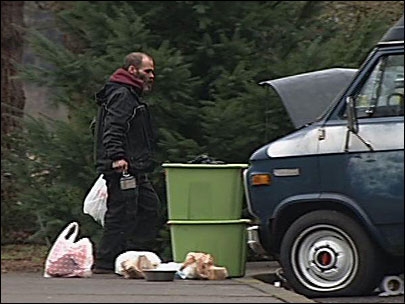OTREC explores best practices for relocating the homeless
Posted on September 18, 2013

One resident prepares to move on, after living at the rest area for nearly 18 years.
OTREC researchers dedicated some time to helping Department of Transportation staff members face a problem that isn’t strictly part of their job description: how best to deal with homeless individuals and households living in DOT rights-of-way and rest areas.
As owners of some of the largest stretches of public land, DOTs have to maintain the land for public use, but may lack resources to address the social welfare aspects of the stewardship of public land.
Homeless individuals and families sometimes seek shelter in rest areas, drawn to the facilities available there. When an established homeless encampment begins to interfere with the rest area’s intended function or threaten the safety of its users, the state DOT may need to intervene.
In 2010, the Baldock Restoration Group relocated 37 homeless households from the Baldock Rest Area near Wilsonville, Oregon. Due to its scale, the Baldock Rest Area relocation provided OTREC researchers with a unique opportunity to analyze the process and consider how best to respond to issues of this nature in the future.
Investigators Ellen Bassett and Andrée Tremoulet of Portland State University set out to determine the extent to which homeless encampments across the country pose an operational and/or safety concern for DOTs, to research best practices related to homeless encampments by DOT staff in other states, and to prepare a case study of the Baldock Rest Area relocation.
The most important lesson from the Baldock case study is that the project was successful largely due to collaboration, with no single agency handling the entire process. The Baldock Restoration Group was multidisciplinary, and its core membership included the Oregon Department of Transportation (ODOT), The Canby Center (a faith-based social service organization), Clackamas County Social Services, Clackamas County District Attorney’s Office, Oregon State Police, Oregon Travel Information Council (OTIC), and Oregon Housing and Community Services.
The Oregon Travel Information Council took over management of the rest area in January 2010, when there was already an established community, more than a decade old, with both chronically and situationally homeless people living there. Rather than react with forceful tactics to this complicated public and human relations situation, OTIC approached it bearing hot chocolate. On January 1, 2010, representatives from OTIC showed up at the Baldock Rest Area with gallons of hot chocolate to serve the community. They stayed for approximately two hours and listened to what individuals had to say, establishing a dialogue and reassuring the people living there that they weren't going to be forced out with nowhere else to go.
In this cooperative effort, there was an overlapping of goals. Social service organizations were primarily concerned with offering assistance to displaced individuals; law enforcement came to the project focused on making the area safer by reducing the criminal activity that centered around Baldock; ODOT and OTIC just wanted the rest area to be able to be restored to its originally intended use.
“We all had different goals, and at the end of the day it was really the same goal,” a member of a social services organization who helped with Baldock said.
The Baldock Restoration Group’s approach was to use a “push-pull” method, combining the “push” force of law enforcement with the “pull” of opportunities for assistance.
The Law Enforcement Strategy Subcommittee worked with ODOT to develop new, more easily enforced rest area rules and provided a firm deadline for the area to be vacated. The Restoration Group members assisted the Baldockeans, as they had come to call themselves, with complying with the rules and deadline.
The Canby Center and Clackamas County Social Services provided intensive, one-on-one assistance to help each willing Baldockean to begin to unravel and address some of the underlying issues that had led to homelessness. They tapped a small pot of one-time-only "flexible funds" provided by the state housing agency to help cover immediate expenses such as gas, the services of mechanics, identification cards, food, camping fees, and other incidental necessities that were required to help the Baldockeans move on.
All three goals were achieved. Two?thirds of the formerly homeless residents were in permanent or transitional housing 16 months after the completion of the project, and nearly half of those who were in unstable living situations had experienced a period of stability before relapsing. Crime in the area was reduced by 70 percent. The homeless encampment was gone, and the Baldock Rest Area now functions primarily as a place for travelers and truck drivers to refresh themselves, sample Oregon’s natural environment, obtain information about attractions and accommodations in the area and, if needed, sleep for a few hours. Along with these visitor functions, the rest area continues to serve a smaller number of transitionally homeless individuals who sleep there in conformance with new rules. But it is no longer home to a round-the-clock resident population.
In addition to the Baldock Case Study, Bassett and Tremoulet compiled a Best Practices Guide for ODOT to use when confronted with similar situations in the future. To read the case study and the best practices guide, and for more details about the research, click here to visit the project page or download the final report.
